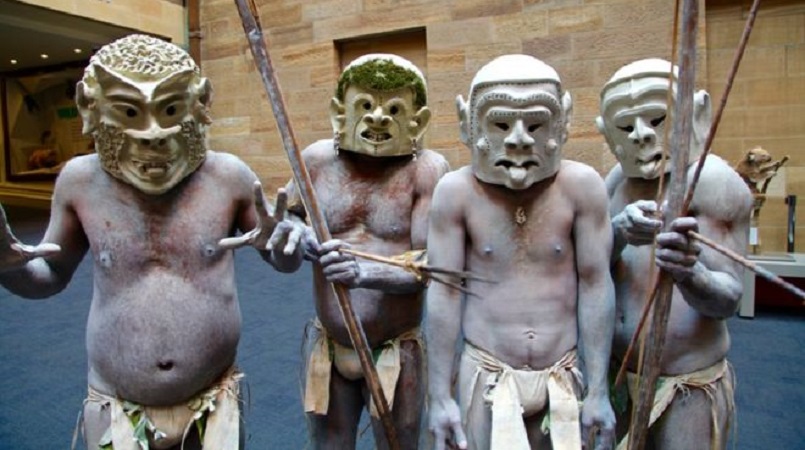
The Asaro "mud men" from Papua New Guinea's eastern highlands are known for their ghoulish clay masks adorned with pigs' teeth and shells.
Four of them have travelled to Sydney's Australian Museum for a new exibition, where Ian Lloyd Neubauer found out more about the masks and the men behind them.
With their skin painted white, elongated bamboo fingers, and of course the eerie masks, the four mud men - who have never left Papua New Guinea's highlands before - are at the Australian Museum for a week as "artists in residence" as it opens a new permanent mud men exhibit.
The museum commissioned Klinit Berry, a former administrator at the University of Goroka in Papua New Guinea (PNG), to travel to the eastern highlands to find Asaro mask artists who might be interested in taking part.
How the mud men began
With no written history, there is no way of pinpointing when the Asaro began making masks, though it is believed the practice has existed for four generations. Ms Berry has one story of the origin of the mask.
"One of the Asaro got married and everyone wore their traditional costumes," she says.
"But one man had no costume, so he took an old bilum (a string bag), cut two holes for his eyes, dipped it mud and also covered his skin with mud, and that was his costume. But when he arrived at the wedding, all the others thought he was a ghost and so instead of celebrating, they fled."
The wedding guests' reaction, Ms Berry continues, gave the man an idea on how to score a decisive victory in a protracted tribal war with a neighbouring tribe.
He convinced his brother and his friends to disguise themselves with masks and mud. "So they covered themselves in mud and attacked the tribe, and that is how they won. The enemy thought ghosts were coming and they ran away without firing a single arrow."
Kori
One of the mask men is 29-year-old subsistence farmer Kori, who was Ms Berry's first contact at Komunive village.
"When she first came to visit and asked about the mask-making ritual, I thought she wanted to bring tourists to our village to watch us dance and buy souvenirs," Kori says. But Komunive is not the only village in PNG where tourists go to see mud men. The concept has been plagiarised by dozens of other tribes for commercial gain.
While on assignment in PNG in 2013, I was taken to a village called Pogla where I saw a dance of the mud men and was told an identical origin story. Plagiarism and commercialisation of the legend, Kori explains, is a big concern for the real descendants of the mud men.
"The government does not recognise or protect our ownership rights and everyone in the highlands is now claiming to be a mud man," he says. "But it's our story and the others have copied it from us. It is a big worry for us because we don't have any copyright protection."
Jim
Jim is the oldest member of the quartet, though he doesn't know how exactly old he is, only that he's in his fifties.
The first time he donned a mud mask was at the 1976 Goroka Show, an annual dance conceived in the 1950s by Australian patrol officers to provide an opportunity for isolated and historically warring tribes to interact in a peaceful environment.
"At first I was scared of the masks and those who wore them, but my father told me this is our culture, you must not be afraid," Jim says. "Now it is part of me and I am happy for the opportunity to come here to share it."
He adds: "I did not know what to expect in Australia, none of us have ever been out of the highlands before, so everything is very interesting. I like the food, especially the chicken and chips. I can't explain how happy I am to have seen the other side of the world."
Kalo
At 19, Kalo is the youngest member of the quartet.
"I came to here to share the culture of the mud men but I never imagined how much interest there would be from the public. The reaction has been amazing," he says.
"The other day, there was an elderly lady here in a wheelchair who asked me to make a mask for her, so I did it.
"Afterwards, she gave me three kisses on the cheek and shook my hand four times. She would not leave till the very end and it made me feel very happy."
The museum says the permanent exhibition is to promote closer ties between the people of the two nations.
"From its closest point, PNG is only 45 minutes' walk from Australia's Torres Strait Islands at low tide, but most of us know very little about it," says Yvonne Carrillo-Huffman, the museum's collections officer.
And as this week of mask-making comes to a close, they are seeing the fruits of this engagement.
"Before I came here today I didn't know anything about the mud men," says Riley Smith, one young student making a mask.
"But now I know that they live in a really remote part of New Guinea and they have to walk one and a half hours from their village to the Asaro River where they get special clay that doesn't crack when it dries."
